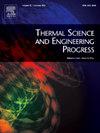具有温度相关特性的空间分数直鳍模型的射击法数值研究
IF 5.1
3区 工程技术
Q2 ENERGY & FUELS
引用次数: 0
摘要
传统上,基于物理现象的模型由整阶微分方程表示。向非整数阶(分数阶)的扩展代表了高度非线性系统建模的重大进步。然而,与整阶模型相比,分数阶微分模型引入了更大的复杂性。本研究旨在分析翅片的物理参数,并评估分数阶对翅片温度和效率分布的影响。为此,采用射击法将原两点边值问题转化为等效的单点问题。然后使用分数阶亚当斯预测校正方法求解得到的系统。为了验证所提出的方法,考虑了两个具有温度依赖特性的直鳍。结果表明,所提出的方法是解决整数阶和分数阶问题的一种有前途的策略。分数阶的变化会影响模型参数,从而影响温度分布和翅片效率。此外,根据分数阶,温度分布可能会与整数阶模型相扭曲,并且与整数阶模型相比,分数阶模型中的传热过程可能更快(或更慢)。对于整阶模型,选择适当的分数阶可以使翅片效率最大化。本文章由计算机程序翻译,如有差异,请以英文原文为准。
Numerical investigation of the Space-Fractional Straight Fin Model with temperature-dependent properties using the Shooting Method
Traditionally, models based on physical phenomena are represented by integer-order differential equations. The extension to non-integer (fractional) orders represents a significant advancement in modeling highly nonlinear systems. However, fractional differential models introduce greater complexity compared to integer-order models. This study aims to analyze the physical parameters and evaluate the influence of fractional orders on the temperature and efficiency profiles of fins. To achieve this, the original two-point boundary value problem is transformed into an equivalent single-point problem using the Shooting Method. The resulting system is then solved using the Fractional Adams Predictor–Corrector Method. To validate the proposed approach, two straight fins with temperature-dependent properties are considered. The results demonstrate that the proposed methodology is a promising strategy for solving both integer and fractional order problems. The change in the fractional order influences the model parameters and, consequently, the temperature profiles and fin efficiency. Furthermore, depending on the fractional order, the temperature profile may be distorted in relation to the integer-order model, and the heat transfer process may be faster (or slower) in fractional order models compared to those with an integer order. Regarding the integer-order model, the fin efficiency can be maximized by choosing an appropriate fractional order.
求助全文
通过发布文献求助,成功后即可免费获取论文全文。
去求助
来源期刊

Thermal Science and Engineering Progress
Chemical Engineering-Fluid Flow and Transfer Processes
CiteScore
7.20
自引率
10.40%
发文量
327
审稿时长
41 days
期刊介绍:
Thermal Science and Engineering Progress (TSEP) publishes original, high-quality research articles that span activities ranging from fundamental scientific research and discussion of the more controversial thermodynamic theories, to developments in thermal engineering that are in many instances examples of the way scientists and engineers are addressing the challenges facing a growing population – smart cities and global warming – maximising thermodynamic efficiencies and minimising all heat losses. It is intended that these will be of current relevance and interest to industry, academia and other practitioners. It is evident that many specialised journals in thermal and, to some extent, in fluid disciplines tend to focus on topics that can be classified as fundamental in nature, or are ‘applied’ and near-market. Thermal Science and Engineering Progress will bridge the gap between these two areas, allowing authors to make an easy choice, should they or a journal editor feel that their papers are ‘out of scope’ when considering other journals. The range of topics covered by Thermal Science and Engineering Progress addresses the rapid rate of development being made in thermal transfer processes as they affect traditional fields, and important growth in the topical research areas of aerospace, thermal biological and medical systems, electronics and nano-technologies, renewable energy systems, food production (including agriculture), and the need to minimise man-made thermal impacts on climate change. Review articles on appropriate topics for TSEP are encouraged, although until TSEP is fully established, these will be limited in number. Before submitting such articles, please contact one of the Editors, or a member of the Editorial Advisory Board with an outline of your proposal and your expertise in the area of your review.
 求助内容:
求助内容: 应助结果提醒方式:
应助结果提醒方式:


